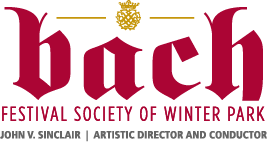Bach Festival Society
Díaz Trio
Andrés Cárdenes, violin
Milena Pajaro-van de Stadt, viola
Andrés Díaz, cello
Thursday, November 19, 2020 • 7:30pm
Tiedtke Concert Hall
View Artist Bios | View Program Notes
FRANZ SCHUBERT String Trio “Allegro” in B-flat Major, D. 471
During the ten-year span between his youthful string quartets and the three late quartet masterpieces of 1824-1826, Schubert's mind and pen were little occupied with string instruments, but he did find time in his astoundingly busy schedule to come up with two string trios, D. 471 and D. 581, both in B-flat major and both composed during the month of September in 1816 and 1817, respectively. The String Trio in B-flat major, D. 471, is an incomplete composition, made up of only a first movement and thirty-nine bars of a second, slower movement. It is a much-loved piece of music where we can hear the nineteen-year-old composer's deep admiration for the music of the Viennese masters whose legacy he inherited—Haydn somewhat; Mozart especially; and maybe Salieri, Schubert’s own teacher until the end of 1816, a little bit. Schubert seems to draw a piece of music from true musical Classicism as he had absorbed it during his childhood in Vienna. It is music of sparkle and wit, and a smile and wink seem appropriate.
Scored for the usual string trio ensemble of violin, viola, and cello, it is in effect a single-movement composition. The sole complete movement is an example of Classical sonata-allegro form, marked Allegro by the composer. The opening theme is given by the violin without introduction, to an accompaniment of oscillating eighth notes in the viola and a long-held B-flat in the cello. After repeating this four-bar pianissimo thought, Schubert offers up some triplets in the violin followed by a transition in which the viola has the pedal-point, and finally to the second theme. This second-theme area shows off “some happy, spiccato mini-cadences and some brilliant, forte descending scales in octaves” (Blair Johnston, Indiana University). The coda to the exposition takes up as much time as the entire exposition did.
Development is simple and straightforward, and most of the development section uses the melodic line with which Schubert closed the final bar of the exposition. The recapitulation is purely classical: the opening theme remains unchanged, the second is adjusted to accommodate the tonic key, and the same alternation of tonic harmony that closed the exposition is applied again to bring the piece to a final cadence.
ERNST VON DOHNÁNYI Serenade in C Major for string trio, Op. 10
Following his establishment of a worldwide reputation as a pianist, composer, conductor, and educator in the years preceding the First World War, Ernst von Dohnányi, a Hungarian, was a contemporary of Martinů, Bartók, and Korngold and as a conductor was an ardent supporter of their works. As a pianist he was considered the most exemplary virtuoso of the instrument since Liszt, and this fact became firmly established during his lifetime. The Serenade for violin, viola, and cello, written by Dohnányi at age 25 while on tour in London and Vienna, premiered in 1905 and marked a distillation of his style. Reflecting 18th-century models, it followed the approach of Dvořák’s two serenades written a quarter-century before. Traditional in flavor, the five-movement work is marked by the classical practice of framing the work by marches, commencing with the vigorous opening, Marcia. A change of pace, reflected in the gentle Magyar themed Romanza that follows the opening, presents a sinuous melody in which the viola, over a pizzicato accompaniment, frames a romantic central section. In complete contrast, the Scherzo is a contrapuntal tour de force that begins with an ethereal fugato that progresses into both lighthearted and slightly melancholy moods. The second slow movement comprises a set of five variations on a poignant, chorale-like theme, occasionally evocative of Schubert’s “Death and the Maiden.” The final section is an energetic sonata rondo that references the first two movements before ending in a compelling finale.
—Karen Jurgens
LUDWIG VAN BEETHOVEN String Trio No. 1 in G Major, Op. 9
Beethoven’s three String Trios, Op. 9, for violin, viola, and violoncello, originally written in 1797, were not published until 1846/1847. These little-known works, a prelude for the early String Quartets, were composed over an interval of many years and had insufficient support at the time, probably due to the complexity involved in performing them and the fact that trios were not fashionable as a form. The limited selection of virtuosi adroit enough to play them, added to the traditionalist mores of 19th-century Vienna, which inclined towards more traditional works, also contributed to their remaining in the shadows of his better-known music. Thought to have been written for the virtuoso violinist Ignaz Schuppanzigh (about whom Beethoven said “Does he believe that I think of a wretched fiddle when the spirit speaks to me?”), Opus 9 is challenging from the outset. Arpeggios mark the start of the Trio No. 1 in G major, soon followed by somewhat demanding sixteenth-note interwoven scales. The unorthodox treatment of the second movement, slow and in a superdominant E major, added to the negative reception this work initially received, as Viennese audiences were unprepared for such startling developments. The scherzo theme is stated in the first violin. It is light and transparent, and most of the thematic material is given to the violinist. The piece ends with a brilliant Presto in which all three instruments share in displaying their virtuosity.
—Wolfram Schwinger
Back to the Main Program Page









